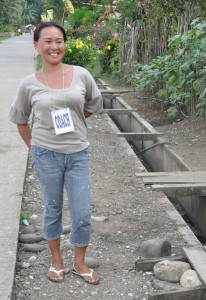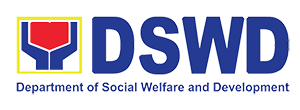
Mercy, beaming with pride, stands beside the concrete canal project that she and her fellow volunteers actively implemented.
Esperanza, Agusan Del Sur – Every time the rain comes during the months of June to September, Mercy Balagon, 38, cannot help but worry about the health of her two daughters.
For the past years, it is during these months that incidence of dengue fever in this town reaches its peak.
Mercy recalls that in 2012, the Department of Health (DOH) declared a dengue outbreak here when it recorded 130 cases.
In her village of Barangay Poblacion alone, 103 dengue cases were noted.
She is thankful though that her daughters were spared.
Mercy blames this alarming increase in dengue cases to the frequent flooding in their community during the rainy season.
“Flooding is one of the major contributors of dengue because the Aedis Egypti mosquito thrives in stagnant water,” Mercy echoes in the vernacular the advisory she heard on radio about this deadly disease.
“Brgy. Poblacion has poor drainage system.”
No more flooding
All through out this year though, Mercy has not shown a bit of worry on her face.
The construction of the drainage system in January through the Kapit-Bisig Laban sa Kahirapan-Comprehensive and Integrated Delivery of Social Services (KALAHI-CIDSS) gave her the peace of mind.
KALAHI-CIDSS is an anti-poverty initiative of the Department of Social Welfare and Development (DSWD). It is a community driven-development (CDD) project where communities are trained to choose, design and implement projects that address their most pressing needs.
With KALAHI-CIDSS, communities and local government units have built school buildings, farm-to-market roads and bridges, health stations, day care centers, common service post-harvest facilities, and many others. These are small-scale but responsive to community-identified needs.
The drainage system project of Brgy. Poblacion is one of those projects. It served as the community’s extended support to the campaign of DOH to help prevent the spread of dengue fever.
With the project, the Center for Health and Development (CHD) of CARAGA showed that there were only 23 dengue cases in the barangay from January to September 2013.
“Dako akong kalipay nga nakita ang kanal sa among barangay. Dili na jud pareha sa una nga pag moulan kay grabe ang baha unya dugay pa jud kaayo mohupa. Hugaw kayo ang tubig ug daghang mga lamok. Karon nga aduna nay kanal, arang-arang na, wala na kaayo ko madungog nga nagka-dengue diri sa among dapit (I am really happy seeing the concrete canal in our barangay. Whenever it rained in the past, we experienced flooding and the dirty stagnant water attracts many mosquitoes. With the construction of a concrete canal, the situation is getting better and I seldom hear cases of dengue),” Mercy narrated.
Best decision
Mercy, who led her fellow villagers in drafting the project proposal for the drainage system, considers this as their best decision.
She said that the good point about KALAHI-CIDSS is that it allows communities to decide which project they need most.
Mercy admitted that prior to her involvement in KALAHI-CIDSS, she was one of those who made negative comments about projects to be implemented in their community.
She used to think that these will not be completed as the funds will just be pocketed by corrupt individuals. It was only when she volunteered that she learned to appreciate KALAHI-CIDSS.
The Process
KALAHI-CIDSS has a five-stage process wherein communities are trained in the systems and processes of CDD.
Its five stages are:
◦ Social Preparation, wherein residents are trained in identifying what their community’s pressing needs are;
◦ Project Development, wherein communities are trained in designing community project proposals that will be able to address their identified concerns. This stage also sees the creation of the criteria, as identified and agreed upon by the community, that will be used later on to determine which of the proposed community projects will be selected and implemented;
◦ Project Approval, wherein the project preparation teams of each barangay will present their sub-project proposals to representatives of the other barangays within the municipality and then vote on which of these will be prioritized using the criteria they have formulated;
◦ Implementation, wherein village teams comprised of volunteers are trained so they themselves will be able to implement their chosen community projects; and,
◦ Transition, wherein weaknesses and strengths during project implementation are assessed to better prepare the community for the next cycle of project implementation.
“Lahi ra gyud ang KALAHI-CIDSS. Na-appreciate jud nako ang proseso sa programa. Bisan ug hago kaayo kay daghang mga dokumento ug grabe kayo ka-kuti (KALAHI-CIDSS is really different from other programs. I appreciate its processes no matter how tedious since there are many documents to be filed and you need to be very meticulous to process these),” Mercy explained.
Mercy volunteered as a bookkeeper for KALAHI-CIDSS in her community. Her task was to record the day-to-day financial transactions of the Barangay Sub-Project Management Committee (BSPMC), the group of KALAHI-CIDSS volunteers working in the implementation of the project. It was her responsibility to ensure that all of these are recorded correctly.
In her eight months as a volunteer, Mercy learned to trust KALAHI-CIDSS, and this inspired her to participate in other community activities.
She is now also involved in the movement against human trafficking.
Mercy’s experiences in KALAHI-CIDSS made her see the real needs of her community.
“I also realized that our village needs responsible citizens who are willing to contribute to community development. Through active participation, people can be motivated to do something and be part of their community’s positive transformation,” Mercy enthused. ###


